How To Avoid Capsizing
The last year (2017) there were 435 accidents that involved flooding/swamping, and 132 of the people involved were injured and another 76 died. This was the second leading cause of boating deaths.
Virtually all of these accidents were the result of operator error, generally attributable to lack of experience and boating education. If you are in a boat that swamps or capsizes, statistics say you have a 37% chance of ending up a fatality.
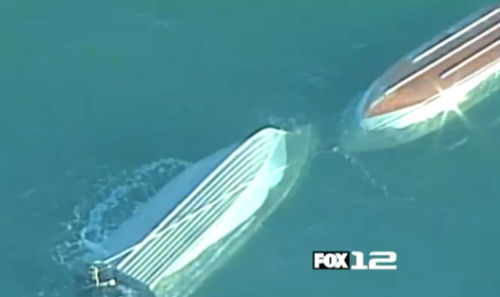 One of these boats was attempting to tow the other off the Oregon coast when both swamped and capsized and two men died. Note that these boats are floating level as required by USCG regs. |
To zero-in on the boaters most likely to be at risk of swamping and capsizing, let's look at three broad, defining criteria—
Boat Size: 85% of all boating fatalities occurred in boats under 26’ in length.
Boat Type: 60% of all recreation boating casualties involved people in open motorboats (54%) or in rowboats (6%).
Boating Activity: While the USCG statistical report does not break out boating fatalities by primary activity (except for skiing), it is clear from looking over the reports that more than 90% of all of the open motorboats and rowboat fatalities involved boats used for fishing, as opposed to sportboats, skiboats, or other types of open motorboats primarily used for other purposes.
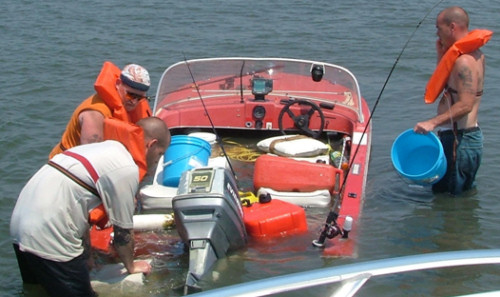 Did these boaters forget to put in the drain plug before launching? Happily these men can stand on the bottom, but not all boaters are so lucky. |
Causes of Swamping
Boats become swamped when excessive water enters them either through holes in the bottom or from over the gunwales. Swamping usually very quickly leads to a boat capsizing due to the free surface effect of water in the hull. Following are leading causes of swamping—
1. Overloading
2. Improper load distribution
3. Freeboard inadequate for sea conditions
4. Towing improperly
5. Other manifestations of operator error
6. Failure of through-hull system integrity
All except item #6 involve the lack of experience, education and/or common sense of the operator. And even item #6 usually involves operator error in as much as proper maintenance was often not carried out, nor were precautions taken to avoid catastrophic malfunction in some cases.
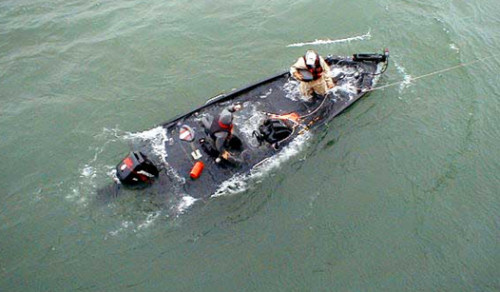 This bass boat is swamped and floating level as it should. If the two boaters aboard had 5-gallon buckets they would have a fighting chance to bail out the boat. Never give up. |
The Operator Is Responsible
All boats are designed to operate safely in a certain range of sea conditions. Generally, small boats with low freeboards are intended for operation in small lakes, rivers, and other protected bodies of water.
Boats with low freeboard are not intended to be taken into large bodies of water, except in calm conditions. It is up to the operator to make a judgment as to what conditions his boat is able to handle.
Sea conditions, even in small lakes, can be too much for a boat in severe weather conditions. Flooding rivers are often too powerful for any motorboat no matter how large or powerful. In all cases, the operator must decide when to venture out in his vessel. It is solely his responsibility as to when to go boating, not that of the USCG or the boat builder.
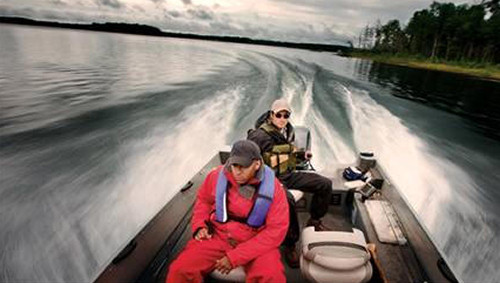 High speed in small boats can quickly lead to a capsize if an underwater object is hit or the skipper makes a sharp turn. A least these boaters are wearing life vests. |
Some Typical Operator Mistakes
In addition to the obvious mistakes of overloading, improper weight distribution, and using a boat in conditions beyond its capabilities, there are several other common mistakes inexperienced boaters make. Here are a few examples—
a. Quick deceleration with the result that the stern wave overtakes the vessels and floods in over the transom.
b. Stuffing the bow into a sea due to excessive speed.
c. Anchoring by the stern.
d. Anchoring too close to the surf or inlets.
e. Making sharp turns at high speed and shipping water as a result.
f. Careless running of inlets.
g. Not observing a change in sea conditions.
h. Forgetting to insert drain plug before launching.
i. Improperly towing another vessel.
j. Trying to raise a fouled anchor with the power of the engine.
k. Not avoiding breaking seas.
l. Speeding in unknown or in shallow waters – nothing will capsize a boat faster than hitting a fixed object under the water at high speed.
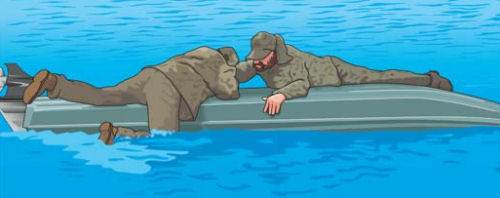 This drawing illustrates how powerboats 20’ and under with an engine larger than 2-hp are supposed to float – level. The reason for that is to give its occupants a viable place to seek refuge and avoid drowning and hypothermia. These two men, of course, should be wearing PFDs. |
Only Power Boats 20’ and Smaller Are Required to Float Level
In 1978 – a long time ago – the USCG required that all powerboats 20’ and smaller with an engine of 2-hp or more must “float level” when swamped. In order to do that with modern boats with large outboard engines it takes a fair degree of sophisticated engineering as to the amount and location of flotation foam.
A BoatTEST.com Caveat
We use the word “required” in the above paragraph because we have read too many reports of people swimming away from boats under 20’ that have reportedly "sunk" to wonder if all boats 20' and under actually meet this requirement. We have also seen pictures of boats in the required class of level flotation that have only their bows showing above the water – i.e. not floating level.
The USCG and NMMA Certification relies on boat builders to meet the regulations for every unit they manufacture. Each unit sold is not tested for level flotation. Consumers of boats 20’ and under should satisfy themselves as to the integrity of the brand they buy.
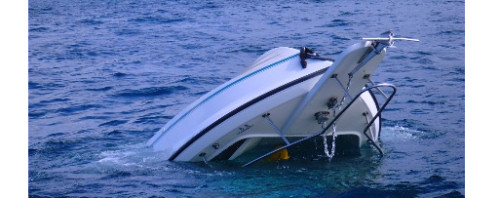 Many open fishing boats over 20’ are described as “unsinkable” or are said to have “foam flotation.” With only a few brands being exceptions, the above scenario is about as much flotation as you can expect from most open boats over 20’ – and many will not do as well. |
Unsinkable Does Not Mean “Level Flotation”
Many builders of open fishing boats over 20’ state that their boats are “unsinkable,” and as far as we know that is usually true. But many boat owners have confused the word “unsinkable” with the mental image of a boat swamped but “floating level.” We only know of three brands that make a claim of “floating level” for boats over 20.'
For the bulk of the open boats over 20’ that claim to be unsinkable, we suggest that you assume that means that these boats will have their bow, and little else, above water if swamped and capsized, and prepare for that possibility.
Quick Dewatering is Imperative
Once any open boat becomes swamped, no matter what its builder claims, it will in most cases capsize quickly even if it has level flotation. That is why once a boat ships some water over the stern, the bow, or abeam, the skipper must take immediate action to avoid taking on any more water which may flood and swamp the boat. Water that is in the boat must be evacuated as quickly as possible. Do not rely on bilge pumps for this job because their capacity is so low as to be worthless in situations like this.
Consider running the boat slowly ahead to move the water out the scuppers or over a cut-away transom. Man your 5-gallon bucket or anything else you might have at hand. Part of the minimum equipment requirements that you need to have on your boat is a manual bilge pump. Now is the time to put it to use. Do not stop until you have most, if not all, of the water out.
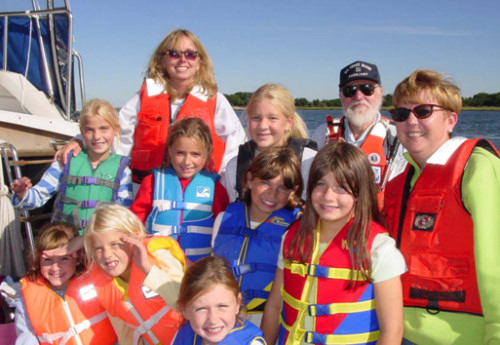 In most states, children less than 12 years old are required by law to wear PFDs at all times and USCG statistics prove the value of this legislation. Every year there are several cases of boating mishaps where the kids survived because of their PFDs, and the parents who did not wear them became fatalities. |
Once water is in the boat, keeping from shipping more water must become the prime consideration for every skipper, and that may mean pointing the boat in the opposite direction of where he wants to go. It may mean that he should head into the seas, or take them at a slight angle to be able to ride up and over and not crash down and bury his bow. It may mean he should seek the lee of an island or obstruction.
When approaching an inlet that is running high or the tide is against the wind, it may be advisable to stay offshore and wait for the weather to pass or the tide to change, or even seek another harbor.
And finding oneself in such a situation certainly means that nearby boats should be alerted and the USCG contacted and asked to standby.
Summary
1. The operator is responsible for the safety of his vessel and its occupants. You are the captain of your boat, and your guests' lives are in your hands. Do not take this responsibility lightly.
2. Everyone aboard, not just the kids, should be wearing a PFD. There are several choices beyond the orange life vests that you probably got for free with your boat. Explore them.
3. Match the boat’s capabilities to the conditions. If in doubt, stay inshore. It's better to be at the dock wishing you were offshore than offshore wishing you were at the dock.
4. Be alert to changes in weather. Storms usually have plenty of warning before they strike. Even the cheapest VHF has a weather button.
5. Be sure to have all USCG-required equipment aboard such as flares and signaling devices.
6. All operators should have a VHF radio handy, not just a cell phone. While you can write down the Coast Guard's number, will you know the number of the boat only 1/2 a mile away?
7. File a float plan with a trustworthy friend.
8. Remember that the best time to head back to shore is when you first think about it.
9. Education is the key. If you choose not to take a class, then we recommend the BoatTEST.com Smart Boating DVD Box set. You can learn at home and it makes a great refresher year after year.
IMPORTANT: The boaters most at risk are not the ones reading this report, but those that are reading it (YOU) have the responsibility to help a boater in need. Please note in the accompanying article how many boaters were saved because alert, Good Samaritan fellow boaters came quickly to their rescue and called for help.
When the going gets rough, keep an eye out for your fellow boaters on the water.